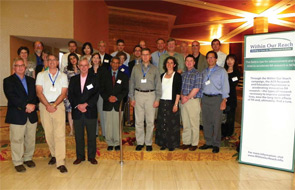So far, he and his team have found that 33 out of 45 patients with RA antibodies show airway disease on high-resolution computed tomography (CT) imaging. However, of the 16 controls without the antibodies, only four show airway disease (p<.01).
A key finding is that joint examinations of at risk subjects showed there was no apparent inflammatory arthritis in those with the lung abnormalities, meaning the lung abnormalities predate any clinical sign of RA. Also, MRIs of 18 subjects showed that 13 of the subjects were without synovitis.
Dr. Deane and his research team are also evaluating lung lavage and sputum to collect cell profiles, autoantibodies, protein citrullination data, cytokine and chemokine levels, and to see whether any pathogens are present that might be driving the autoimmunity.
“Longer-term goals are going to be to expand the sample set—lots more subjects … who are at risk for RA,” Dr. Deane said. “We [also] need more with established RA to understand more of the biology of immune generation in the lungs. And then include longitudinal follow-up for these people to see what happens to them over time.”

Test for Interstitial Lung Disease
Even though there have been advances in finding patients with RA and treating their disease, there has not been much progress in helping patients with RA who develop interstitial lung disease (ILD).
RA-related ILD is usually diagnosed after a patient arrives at the physician’s office with cough and shortness of breath. By then, their options are fairly limited. “They’ve already developed very significant abnormalities,” said Sonye Danoff, MD, PhD, assistant professor at the Johns Hopkins University School of Medicine in Baltimore and co-director of its Interstitial Lung Disease Clinic.
Dr. Danoff, who received ACR REF funding in 2010, is investigating the usefulness of a test that might help give RA patients an earlier picture of their risk and help guide rheumatologists on how to treat them.
Chest CT scans are the tool used to diagnose ILD, but it has been shown that even the most experienced radiologists reading scans can vary widely in their interpretations, even though that study is considered the “gold standard” in evaluating the disease.
Dr. Danoff is evaluating the ability of quantitative CT densitometry to give more reliable results.
It’s really been very beneficial to have all the researchers come together and not only show their progress but to get ideas and feedback and establish collaborations.
—David Karp, MD, PhD
CT scans are collections of pixels at varying densities. In quantitative CT densitometry, each pixel’s density is assessed, using a computer algorithm, and then is assigned to a range. A pixel with a density reading of zero is bone and a reading of -1000 is interpreted as emphysema.
